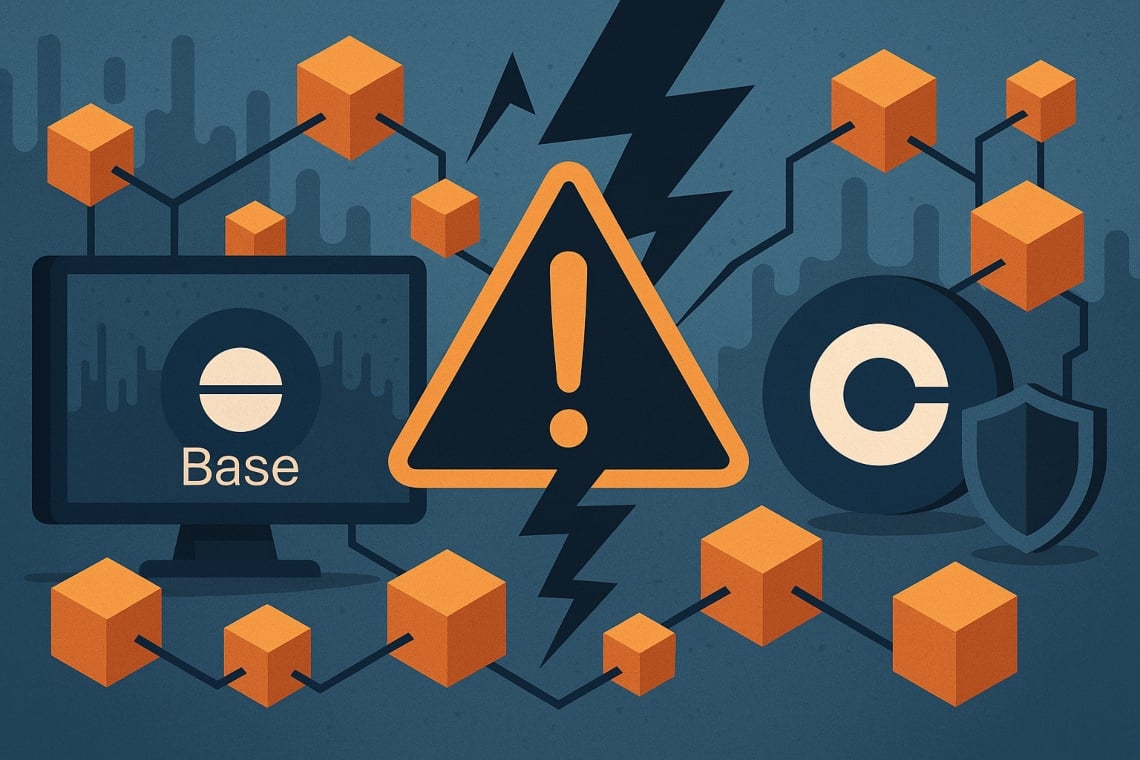Blackout in the Base blockchain: explosive growth of tokens

The Base blockchain network, promoted by Coinbase, experienced a sudden 29-minute blackout in block production at the beginning of August 2025.
The event, which occurred on the morning of August 5 at 6:15 UTC, reignited the debate on the stability of Layer 2 networks and highlighted the speed at which technological evolution is occurring in the sector.
This stop, the first of such duration in Base’s history, raises doubts about the resilience of the project just as the ecosystem is experiencing significant expansion.
According to the data collected by various network monitors and industry analysts, Layer 2 networks like Base show a rapid increase in operational complexity that can test their ability to ensure prolonged stability.
Experts observe how rapid expansion represents both a great opportunity and a significant risk for security and continuous operation.
What caused the blackout on the Base blockchain: causes and context
The interruption of the Base chain occurred at block 33,792,704. Block production stopped for 29 minutes, then resumed regularly. The technical details behind the problem have not been made public by the Base team.
The official blockchain status page confirms the duration and timing of the blackout on the site status.base.org.
This episode represents the longest downtime ever recorded since the network’s inception and has raised questions about the solidity of the OE stack (Optimism Ethereum), on which Base relies.
An interesting aspect is that the blackout occurred simultaneously with an unprecedented peak in the creation of new tokens on the Base blockchain.
According to recent data published by bitcoinethereumnews.com and CoinGecko, over 100,000 new tokens were minted in a single day, a significant jump compared to the previous average of about 6,600 daily tokens.
This figure significantly surpasses competitors like Solana. Below are some key numbers extracted from Dune Analytics and industry reports:
- From ~6,600 to over 100,000 new tokens generated in 24 hours
- ZORA: capitalization rose to about 200 million dollars
- Other tokens like Zeebu, Wormhole, and YGG: capitalizations respectively exceeding 485, 355, and 80 million dollars
- Daily transactions with volumes exceeding 12 million dollars
“`html
The main engine behind this expansion is integration with social platforms such as Zora (on-chain art) and Farcaster.
It allows each post to instantly generate new coins for the creators. In this context, Base contributes to the spread of crypto and the growth of the creator economy.
“`
[N.B. The data mentioned are updated to July 2025 and come from public sources such as Dune Analytics and CoinGecko]
Among the most significant innovations implemented on the Base chain is the release of Flashblocks, a solution that has allowed the reduction of block creation time from 2 seconds to 200 milliseconds.
This update was introduced on the mainnet in the early months of 2025 and has given the platform an unprecedented reputation for efficiency and speed.
Thanks to this, Base enables global capital transfers at costs lower than 0.01 dollars per transaction, with confirmations almost in real-time.
The stated goal is to meet the growing demand for integrated services such as payments in USDC, on-chain identity management, social network, and yield farming, all orchestrated in a single decentralized hub.
Lightning-fast growth, high risks: the ‘dark side’ of Base expansion and the creator economy
Despite the rapid growth and enthusiasm around the Base chain, there are also growing concerns on the security front.
The accelerated spread of smart contracts has fostered the creation of new on-chain index funds and other initiatives, as highlighted by Jesse Pollak, a well-known Base developer in various public sessions and community meetings.
Recently, an exploit against Arcadia Finance contracts caused an estimated loss of about 2.5 million dollars, confirmed by security analyses.
A previous attack, dating back to July 2023, resulted in a theft of about 455,000 dollars.
The identified vulnerabilities particularly concern a lack of user input validation and insufficient defenses against reentrancy attacks, often linked to the rush to launch new projects.
To address these issues, Coinbase has launched a $5 million bug bounty through the Cantina platform.
This initiative involves ethical hackers globally with the aim of finding critical vulnerabilities in Base’s smart contracts and other related on-chain products. It is one of the most significant Web3 security operations underway.
The measure comes following a series of incidents, including a recent data leak that affected about 70,000 users of Coinbase and extortion attempts for a ransom expected to be around 20 million dollars.
Additionally, Coinbase has publicly confirmed the dynamics of a bribe to internal employees to facilitate the data breach, as documented by therecord.media.
Blackout and series of incidents: not only Base, but also Sui, Avalanche, Solana, and TON
The blackout of Base does not represent an isolated case. In recent months, similar disruptions have occurred on blockchains like Sui, TON, Avalanche, and multiple times on the Solana network.
For example, on June 1, 2025, TON experienced a 40-minute halt caused by technical issues, as reported by bitget.com.
Sui experienced a pause of over an hour in November 2024, due to a DOS-type bug. Solana, on the other hand, has recorded several significant outages in recent years, including one of the longest in February 2024 status.solana.com.
These episodes demonstrate how the challenge of ensuring stability and reliability at the enterprise level still represents a strong limitation for the large-scale adoption of Layer 1 and Layer 2 blockchains.
It must be said that the temporary interruption did not cause loss of funds for Base users, whose operations were regularly restored at the end of the blackout.
Coinbase, for its part, has intensified active monitoring to maintain network security. The community, however, remains vigilant, and the increasing complexity of the Base system continues to be observed rigorously.
The interruption of the Base blockchain highlights the challenges inherent in rapid growth within the DeFi. On one hand, the impressive increase in the number of tokens and the technological advancements driven by Coinbase demonstrate the project’s potential.
On the other hand, the need to invest in a structured manner in code verification, transparency, and cooperation with ethical hackers clearly emerges.
Only with these measures can Base maintain its position as a fast and reliable blockchain in the near future.

